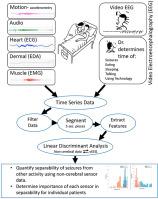Computers in Biology and Medicine ( IF 7.0 ) Pub Date : 2021-01-21 , DOI: 10.1016/j.compbiomed.2021.104232 Alexandra Hamlin 1 , Erik Kobylarz 2 , James H Lever 3 , Susan Taylor 3 , Laura Ray 1

|
This paper investigates the feasibility of using non-cerebral, time-series data to detect epileptic seizures. Data were recorded from fifteen patients (7 male, 5 female, 3 not noted, mean age 36.17 yrs), five of whom had a total of seven seizures. Patients were monitored in an inpatient setting using standard video-electroencephalography (vEEG), while also wearing sensors monitoring electrocardiography, electrodermal activity, electromyography, accelerometry, and audio signals (vocalizations). A systematic and detailed study was conducted to identify the sensors and the features derived from the non-cerebral sensors that contribute most significantly to separability of data acquired during seizures from non-seizure data. Post-processing of the data using linear discriminant analysis (LDA) shows that seizure data are strongly separable from non-seizure data based on features derived from the signals recorded. The mean area under the receiver operator characteristic (ROC) curve for each individual patient that experienced a seizure during data collection, calculated using LDA, was 0.9682. The features that contribute most significantly to seizure detection differ for each patient. The results show that a multimodal approach to seizure detection using the specified sensor suite is promising in detecting seizures with both sensitivity and specificity. Moreover, the study provides a means to quantify the contribution of each sensor and feature to separability. Development of a non-electroencephalography (EEG) based seizure detection device would give doctors a more accurate seizure count outside of the clinical setting, improving treatment and the quality of life of epilepsy patients.
中文翻译:

评估使用非脑传感器数据检测癫痫发作的可行性
本文探讨了使用非大脑时间序列数据检测癫痫发作的可行性。记录了15例患者的数据(男7例,女5例,未记录3例,平均年龄36.17岁),其中5例总共发作了7次。使用标准的视频脑电图(vEEG)在住院环境中对患者进行监测,同时还佩戴传感器来监测心电图,皮肤电活动,肌电图,加速度计和音频信号(发声)。进行了系统,详细的研究,以识别传感器和源自非脑传感器的特征,这些特征对癫痫发作期间获取的数据与非癫痫发作数据的可分离性贡献最大。使用线性判别分析(LDA)对数据进行后处理表明,基于从记录的信号中得出的特征,癫痫发作数据与非癫痫发作数据具有很强的可分离性。使用LDA计算的数据收集过程中发生癫痫发作的每位患者的接收者操作员特征(ROC)曲线下方的平均面积为0.9682。对于癫痫发作检测最重要的功能因患者而异。结果表明,使用指定的传感器套件进行癫痫发作检测的多模式方法有望以敏感性和特异性检测癫痫发作。此外,该研究提供了一种量化每个传感器和特征对可分离性的贡献的方法。











































 京公网安备 11010802027423号
京公网安备 11010802027423号